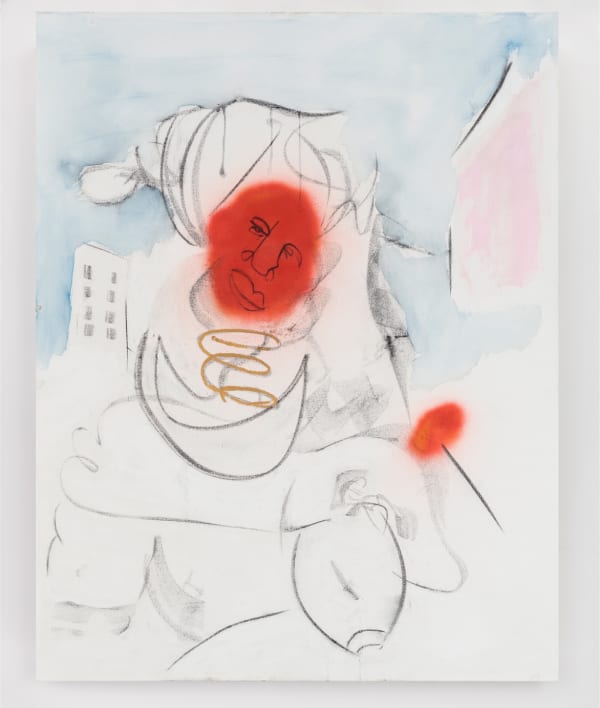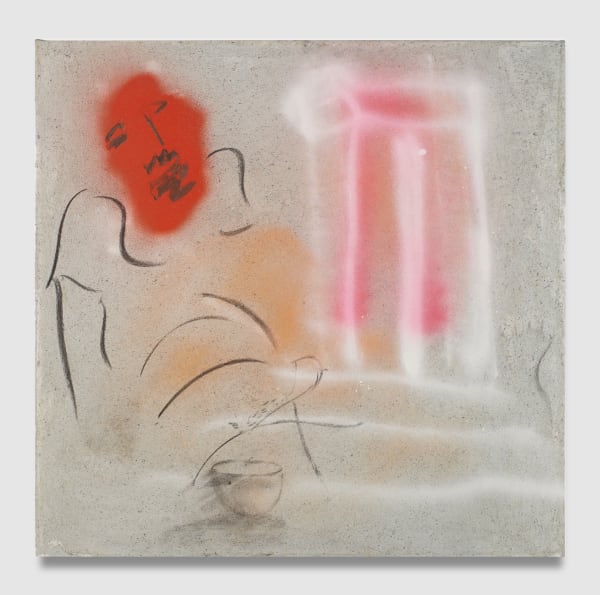-
“I realized that this is my chorus; this is my ad-lib; this is the moment I can keep coming back to and expand upon. When I discovered that red, it felt like it will be important and fruitful for me to dive into this. And it just started to grow from that.” –Curtis Talwst Santiago
-

-
“My Voice Can Be Like Charcoal” focuses on Santiago’s paintings and works- on-paper, many of which feature figures, their faces formed in bursts of red color, around which swirl quick, expressive lines of charcoal or paint. Curtis Talwst Santiago’s protagonists embrace, dance and pose with lyrical joy.
-

-
In the studio one night, Santiago recalls, while working on a painting, he applied a circular spray of luminous red paint, that became a head for one of his figures. At that moment, he says, it all came flooding back: his first childhood trip to Trinidad - the island from which his parents emigrated in the late 60s; seeing friends and relatives transform themselves for Carnival; the morning light as it played across his family’s clay-streaked faces, the rising sun activating the life and energy of J’Ouvert, the festival’s first day. Curtis Talwst Santiago, his friends and relatives celebrated their lives, triumphs and struggles, and honored their ancestors. He writes, “I realized that this is my chorus; this is my ad-lib; this is the moment I can keep coming back to and expand upon. When I discovered that red, it felt like it will be important and fruitful for me to dive into this. And it just started to grow from that.”
-

-
An accomplished singer and artist, Santiago’s synesthesia attends to multiple modes of expressions and sensory experiences. Santiago notes that if he listens to certain music, “There’s a certain type of drawing I’m going to make because of the rhythm, the sonics. Now I know how to use these little superpowers. My voice can be like charcoal."
-

-
Drawing Center chief curator Claire Gilman writes that for Santiago, “different materials serve different functions. Charcoal, the oldest material in the world, represents an anchor or grounding, however tentative. By contrast ... spray paint is a performative medium - one that registers on his surfaces like a shooting star, leaving dusty traces of its forward momentum.” In Curtis Talwst Santiago’s works, line and color function together to create distinct pictorial moments that offers portals to different temporal and sensorial realities.
-

-
Santiago used to live in New York. He now lives in Munich, and he just returned from Senegal, where he lived and worked for two months at Black Rock Senegal, the residency program in Dakar organized by Kehinde Wiley. This mixing of time, space and artistic traditions opens doors in Santiago’s work for the past, present and future, the known and the mythic.
-

-
In fact, Santiago spent many years in Europe studying paintings in museums, working in particular in Portugal. As curator Claire Gilman again writes in Portugal, “Santiago became interested in the seventeenth-century capriccios - landscape paintings where the real and the imaginary, and the contemporary and the anachronistic, share the same fantastical space. For Santiago, the capriccio served as a paradoxically vital corrective to orthodox histories, modeling an alternative to colonial narrativization in favor of multiple, non-hierarchical temporalities.” “Capriccio means imagination,” Santiago observes. His work places the viewer in a space of contemplation and interaction, in dialogue with knights, nobles, poets, painters, dancers and regular folk, giving us a chance to examine ourselves, what can become, and where we come from.
-

-
Works by Curtis Talwst Santiago
Click image to inquire-
 Curtis Talwst Santiago, Granadilla, 2017
Curtis Talwst Santiago, Granadilla, 2017 -
 Curtis Talwst Santiago, Mother and Mango, 2017
Curtis Talwst Santiago, Mother and Mango, 2017 -
 Curtis Talwst Santiago, Sweater Weather, 2018
Curtis Talwst Santiago, Sweater Weather, 2018 -
 Curtis Talwst Santiago, Untitled, 2016
Curtis Talwst Santiago, Untitled, 2016 -
 Curtis Talwst Santiago, Untitled, 2016
Curtis Talwst Santiago, Untitled, 2016 -
 Curtis Talwst Santiago, Leave the Carnival of Time, 2019
Curtis Talwst Santiago, Leave the Carnival of Time, 2019 -
 Curtis Talwst Santiago, Untitled, 2019-2020
Curtis Talwst Santiago, Untitled, 2019-2020
-
-
Press Release
Philip Martin Gallery is proud to present an on-line exhibition of works by Canadian-born, Munich-based artist, Curtis Talwst Santiago. Many of the works in the exhibition appeared in or grew out of Santiago’s recent exhibition, “Can’t I Alter,” at The Drawing Center in New York.
“My Voice Can Be Like Charcoal” focuses on Santiago’s paintings and works- on-paper, many of which feature figures, their faces formed in bursts of red color, around which swirl quick, expressive lines of charcoal or paint. Curtis Talwst Santiago’s protagonists embrace, dance and pose with lyrical joy. In the studio one night, Santiago recalls, while working on a painting, he applied a circular spray of luminous red paint, that became a head for one of his figures. At that moment, he says, it all came flooding back: his first childhood trip to Trinidad - the island from which his parents emigrated in the late 60s; seeing friends and relatives transform themselves for Carnival; the morning light as it played across his family’s clay-streaked faces, the rising sun activating the life and energy of J’Ouvert, the festival’s first day. Curtis Talwst Santiago, his friends and relatives celebrated their lives, triumphs and struggles, and honored their ancestors. He writes, “I realized that this is my chorus; this is my ad-lib; this is the moment I can keep coming back to and expand upon. When I discovered that red, it felt like it will be important and fruitful for me to dive into this. And it just started to grow from that.”
An accomplished singer and artist, Santiago’s synesthesia attends to multiple modes of expressions and sensory experiences. Santiago notes that if he listens to certain music, “there’s a certain type of drawing I’m going to make because of the rhythm, the sonics. Now I know how to use these little superpowers. My voice can be like charcoal.” Drawing Center chief curator Claire Gilman writes that for Santiago, “different materials serve different functions. Charcoal, the oldest material in the world, represents an anchor or grounding, however tentative. By contrast ... spray paint is a performative medium - one that registers on his surfaces like a shooting star, leaving dusty traces of its forward momentum.” In Curtis Talwst Santiago’s works, line and color function together to create distinct pictorial moments that offers portals to different temporal and sensorial realities.
Santiago used to live in New York. He now lives in Munich, and he just returned from Senegal, where he lived and worked for two months at Black Rock Senegal, the residency program in Dakar organized by Kehinde Wiley. This mixing of time, space and artistic traditions opens doors in Santiago’s work for the past, present and future, the known and the mythic. In fact, Santiago spent many years in Europe studying paintings in museums, working in particular in Portugal. As curator Claire Gilman again writes in Portugal, “Santiago became interested in the seventeenth-century capriccios - landscape paintings where the real and the imaginary, and the contemporary and the anachronistic, share the same fantastical space. For Santiago, the capriccio served as a paradoxically vital corrective to orthodox histories, modeling an alternative to colonial narrativization in favor of multiple, non-hierarchical temporalities.” “Capriccio means imagination,” Santiago observes. His work places the viewer in a space of contemplation and interaction, in dialogue with knights, nobles, poets, painters, dancers and regular folk, giving us a chance to examine ourselves, what can become, and where we come from.
Curtis Talwst Santiago (b. 1979, Edmonton, Alberta) has an upcoming solo show at Capsule Gallery (Shanghai, China). His work has recently the subject of “Liming” at The Gate/Imagine the City (Hamburg, Germany). Santiago’s work has been the subject of recent solo and two-person exhibitions at The Drawing Center (New York, NY); Eli and Edythe Broad Art Museum at Michigan State University (East Lansing, MI); Martina Simeti (Milan, Italy); Rachel Uffner Gallery (New York, NY); Cooper Cole Gallery (Toronto, Ontario); and Gallery MOMO (Johannesburg, South Africa). Santiago’s work has been included in group exhibitions at Studio Museum in Harlem (New York, NY); New Museum (New York, NY); The FLAG Art Foundation (New York, NY); The Aldridge Museum (Ridgefield, CT); Institute of Contemporary Art at Virginia Commonwealth University (Richmond, VA); SCAD Museum of Art, Savannah College of Art and Design (Savannah, GA); Pérez Art Museum Miami (Miami, FL); Paul R. Jones Museum (Tuscaloosa, AL); and Osage Art Foundation (Hong Kong, China). Santiago’s work is in the permanent collection of the Studio Museum in Harlem (New York, NY). His work has been featured in numerous publications including Artforum, Forbes, the New York Times, The New Yorker, Hyperallergic, Cultured Magazine, ARTNews and the Financial Times. Santiago lives and works between New York, NY, Lisbon, Portugal, and Toronto, Canada.
Curtis Talwst Santiago’s exhibition is on view on-line November 17 – December 1, 2021.
-
To inquire about works by Curtis Talwst Santiago, click here.
Curtis Talwst Santiago: My Voice Can Be Like Charcoal
Past viewing_room













